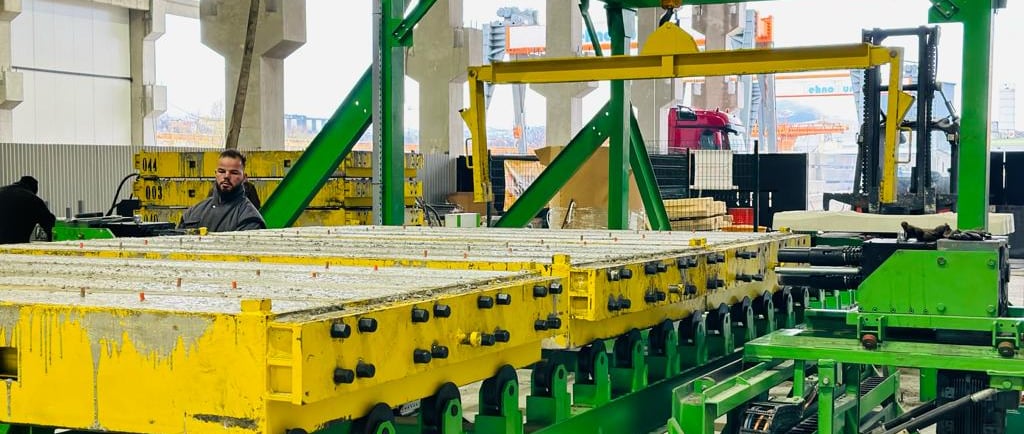Carousel Concrete Sleeper Manufacturing Plants
9/8/20245 min read


Carousel Concrete Sleeper Manufacturing Plants
Railways are vital components of modern infrastructure, facilitating the movement of goods and passengers across vast distances. A critical part of any railway system is the sleeper (also known as a cross tie or railroad tie), which supports the rails and ensures the stability and durability of the track. Concrete sleepers have become the preferred choice due to their strength, longevity, and low maintenance compared to traditional wooden or steel alternatives. The production of concrete sleepers is a highly specialized process, with carousel concrete sleeper manufacturing plants being one of the most efficient and effective systems for producing these critical components. This essay will explore the importance of sleepers in railway systems, the manufacturing process in carousel plants, and the advantages of using concrete sleepers in modern rail infrastructure.
Sleepers and Their Role in Railways
Sleepers, also referred to as cross ties or railroad ties, are structural components that lie transversely beneath railway tracks. Their primary functions are to:
1. Support and Distribute Load: Sleepers help distribute the weight of passing trains evenly across the track bed, preventing excessive stress on the rails and the ground below.
2. Maintain Track Gauge: Sleepers hold the rails in place at the correct gauge (the distance between the rails), ensuring that trains can travel smoothly and safely. Maintaining proper gauge is essential for preventing derailments and ensuring the long-term integrity of the track.
3. Dampen Vibrations: Trains generate significant vibrations when they move at high speeds or carry heavy loads. Sleepers absorb and reduce these vibrations, protecting the rail infrastructure from wear and tear.
4. Improve Stability: Sleepers anchor the track into the ballast (a bed of crushed stone beneath the sleepers), providing stability to the entire railway system. This is crucial for maintaining the alignment of the rails, especially under heavy and repeated loads.
The material used for sleepers has evolved over time. Traditional sleepers were made from wood, but due to concerns over durability, maintenance, and environmental impact, concrete sleepers have become the material of choice in most modern rail systems. Concrete sleepers offer superior longevity, require less maintenance, and can handle higher loads, making them ideal for high-speed and heavy-haul railway lines.
The Carousel Concrete Sleeper Manufacturing Plant
Carousel concrete sleeper manufacturing plants are highly efficient systems designed to produce large quantities of concrete sleepers with consistent quality. The term "carousel" refers to the rotating, continuous production process where sleeper molds move through different stages in a circular or looped configuration. This method ensures high output and uniformity across all produced sleepers.
The production process in a carousel plant typically involves the following stages:
1. Raw Material Preparation: The first step is preparing the raw materials, including cement, aggregates (sand, gravel, or crushed stone), water, and any necessary additives (such as superplasticizers or silica fume) to enhance the durability and strength of the sleepers. The materials are thoroughly mixed in a concrete batching plant.
2. Molding and Reinforcement: The concrete mixture is poured into molds that give the sleepers their specific shape and dimensions. Reinforcement is critical for concrete sleepers, and steel tension wires or bars are typically embedded within the mold before the concrete is added. These reinforcement elements make the sleepers capable of withstanding the heavy loads exerted by passing trains.
In a carousel plant, multiple molds move continuously on a conveyor system, allowing for the simultaneous filling and reinforcement of multiple sleepers, speeding up production.
3. Compaction and Vibration: To ensure that the concrete fills every part of the mold and that there are no air voids, the molds undergo a compaction process. In many carousel plants, vibration is applied to the molds during this stage to ensure dense, uniform concrete that meets structural standards.
4. Curing: After the concrete is poured and compacted, the sleepers must cure to reach their full strength. In a carousel plant, this is often done in a steam-curing chamber, where the temperature and humidity are carefully controlled. Steam curing accelerates the hardening process, allowing the sleepers to reach the required strength more quickly than traditional curing methods. This is particularly important in high-volume production environments where fast turnaround times are needed.
5. Demolding and Quality Control: Once the curing process is complete, the concrete sleepers are removed from the molds. At this stage, they undergo quality control tests to ensure that they meet the required specifications for strength, durability, and dimensional accuracy. Common tests include load-bearing capacity, resistance to cracking, and dimensional checks.
6. Finishing and Stacking: The final stage involves finishing the sleepers, which may include surface treatments or the application of identifying marks. The sleepers are then stacked and stored for transportation to rail construction sites.
Advantages of Carousel Plants in Sleeper Production
Carousel concrete sleeper manufacturing plants offer several advantages over other production methods, particularly in terms of efficiency and consistency:
1. High Production Capacity: Carousel plants are designed for continuous, large-scale production. By automating the entire process—from molding to curing and demolding—these plants can produce thousands of sleepers per day, meeting the demands of large infrastructure projects.
2. Consistency in Quality: Since the production process is highly controlled and automated, the sleepers produced in a carousel plant exhibit a high degree of consistency in terms of strength, size, and durability. This uniformity is critical for rail infrastructure, where variations in sleeper quality can compromise the safety and longevity of the track.
3. Reduced Labor Costs: The automation of the production line reduces the need for manual labor, leading to cost savings for manufacturers. Fewer workers are required to operate the machinery, and the need for manual handling of the sleepers is minimized.
4. Faster Curing Times: The use of steam curing accelerates the production process, reducing the time it takes for sleepers to reach their required strength. This allows for faster project completion times, making carousel plants ideal for large-scale rail infrastructure projects with tight deadlines.
5. Flexibility in Design: Carousel plants can be adjusted to produce sleepers of different sizes and specifications, depending on the requirements of the railway project. This flexibility is important for accommodating various rail systems, whether they are designed for high-speed trains, heavy-haul freight, or urban transit systems.
Importance of Concrete Sleepers in Modern Railway Systems
Concrete sleepers have become the preferred choice for modern railway systems due to their numerous advantages over traditional materials:
1. Durability: Concrete sleepers are far more resistant to environmental factors such as moisture, pests, and temperature fluctuations compared to wooden sleepers. This durability translates to a longer lifespan, reducing the need for frequent replacements and lowering maintenance costs.
2. Strength: The use of reinforced concrete allows sleepers to bear heavy loads without cracking or deforming, making them suitable for high-speed rail systems and freight lines that carry significant weight.
3. Stability: Concrete sleepers provide excellent stability for the track, preventing unwanted movement of the rails and ensuring that the track remains properly aligned over time. This is especially important in regions with high traffic density or where trains travel at high speeds.
4. Sustainability: Unlike wooden sleepers, which require the felling of trees, concrete sleepers are more environmentally sustainable. The materials used in their production are abundant, and many manufacturers incorporate recycled materials into the concrete mix, further reducing the environmental impact.
Conclusion
Concrete sleepers are essential to the safety, stability, and longevity of modern railway systems, providing critical support to the rails and ensuring the smooth operation of trains. The carousel concrete sleeper manufacturing plant represents the pinnacle of efficiency and precision in the production of these vital components. With its high production capacity, automation, and consistency in quality, the carousel plant ensures that concrete sleepers meet the rigorous demands of modern rail infrastructure. As railway networks continue to expand globally, the role of carousel plants in producing high-quality sleepers will remain indispensable for the continued growth and sustainability of the rail industry.
